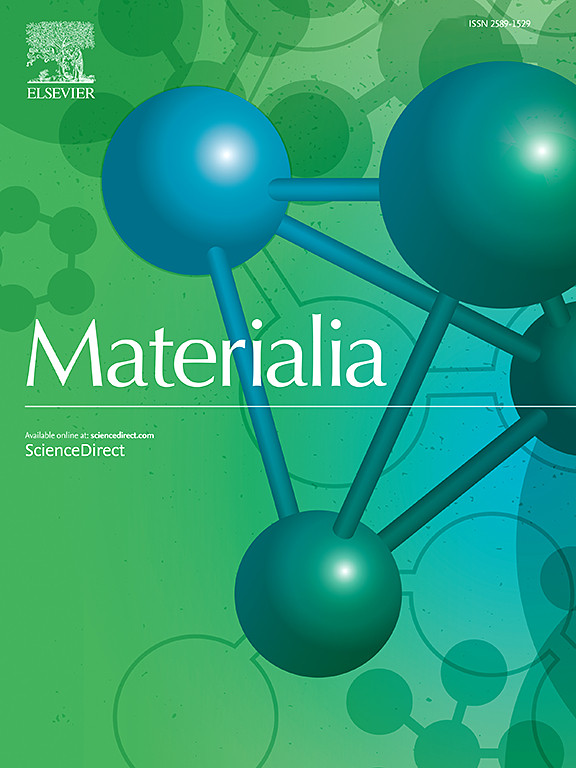双丝钨惰性气体法不锈钢多道焊缝残余应力应变、显微组织及力学性能研究
IF 3
Q2 MATERIALS SCIENCE, MULTIDISCIPLINARY
引用次数: 0
摘要
厚构件(如底板或管)的钨惰性气体焊接需要倒角和多道次焊接,这可能会产生显著的残余应变和应力。在焊接过程中,应变可能导致不对准和偏离所需的零件几何形状,而应力可能损害完整性和使用寿命。研究了采用双丝钨惰性气体(DW-TIG)工艺的不锈钢多道焊缝的残余应力、应变、显微组织和力学性能。两种填充金属,奥氏体304 L和马氏体415不锈钢,用于焊接20mm厚的304 L底板,与单线参考焊缝相比,采用交替和分级填充策略。利用中子衍射法和轮廓法确定了残余应力,并通过轮廓术评估了宏观畸变。通过电子背散射衍射、显微摄影和维氏硬度测试分析了显微组织。通过拉伸试验评估焊缝力学性能,并与标准进行比较。结果表明,等高线法与中子衍射结果吻合较好,差异在100 MPa以下。替代策略在不放大应力的情况下实现了最显著的应变降低(18%),提供了残余应力、应变和机械性能之间的最佳折衷。马氏体相变是产生压应力的关键机制。研究结果证明了DW-TIG焊接在减少变形、减少材料浪费和加强应力场控制方面的潜力,使该工艺适用于工业环境(用于厚部件焊接或部件重新加载)。未来的工作将探索替代填充策略和低能量焊接参数,以进一步提高晶粒细化和力学性能。本文章由计算机程序翻译,如有差异,请以英文原文为准。

Investigation of the residual stresses and strains, microstructure and mechanical properties of stainless steel multipass welds produced using dual wire-tungsten inert gas process
Tungsten inert gas welding of thick components, such as baseplates or tubes, requires chamfering and multipass welding, which can induce significant residual strains and stresses. Strain might then be responsible for misalignments during welding and deviations from the desired part geometry while stress can compromise the integrity and service life. This study investigates the residual stresses, strains, microstructure, and mechanical properties of stainless steel multipass welds using the Dual-Wire Tungsten Inert Gas (DW-TIG) process. Two filler metals, austenitic 304 L and martensitic 415 stainless steels, were used to weld 20 mm thick 304 L baseplates, employing alternated and graded filling strategies compared to single-wire reference welds. Residual stress was determined using neutron diffraction and the contour method, with macroscopic distortion evaluated via profilometry. Microstructure was analyzed via electron backscatter diffraction, micrographs and Vickers hardness tests. Weld mechanical performances were assessed trough tensile tests and compared to standards. The results show strong agreement between the contour method and neutron diffraction, with discrepancies below 100 MPa. The alternated strategy achieved the most significant strain reduction (18 %) without amplifying stress, providing the best compromise between residual stress, strain, and mechanical performance. Martensitic transformation emerged as a key mechanism, introducing compressive stresses. The findings demonstrate the potential of DW-TIG welding to reduce distortions, minimize material waste, and enhance stress field control, making the process applicable to industrial settings (for thick components welding or part reloading). Future work will explore alternative filling strategies and lower-energy welding parameters to further enhance grain refinement and mechanical performance further.
求助全文
通过发布文献求助,成功后即可免费获取论文全文。
去求助
来源期刊

Materialia
MATERIALS SCIENCE, MULTIDISCIPLINARY-
CiteScore
6.40
自引率
2.90%
发文量
345
审稿时长
36 days
期刊介绍:
Materialia is a multidisciplinary journal of materials science and engineering that publishes original peer-reviewed research articles. Articles in Materialia advance the understanding of the relationship between processing, structure, property, and function of materials.
Materialia publishes full-length research articles, review articles, and letters (short communications). In addition to receiving direct submissions, Materialia also accepts transfers from Acta Materialia, Inc. partner journals. Materialia offers authors the choice to publish on an open access model (with author fee), or on a subscription model (with no author fee).
 求助内容:
求助内容: 应助结果提醒方式:
应助结果提醒方式:


